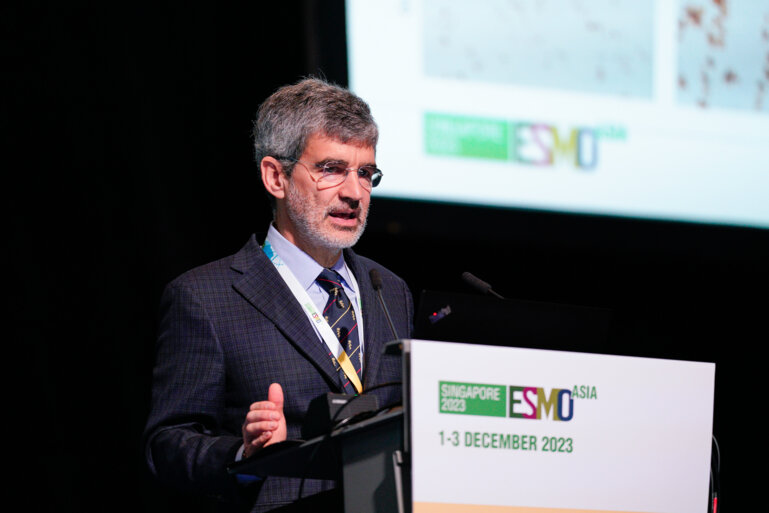In a phase III trial, lower doses of adjuvant radiotherapy plus docetaxel were associated with reduced toxicity and need for percutaneous endoscopic gastrostomy, with an impact on quality of life
As recently reported in a paper published in the Lancet Oncology, de-escalating adjuvant radiotherapy from a standard dose of 60 Gy to 30-36 Gy led to fewer cumulative chronic grade 3 or higher toxic effects, reduced need for percutaneous endoscopic gastrostomy (PEG) tube, and improved quality of life (QoL) in patients with high or intermediate risk human papilloma virus (HPV)-associated oropharyngeal squamous cell carcinoma (Lancet Oncol 2025; 26: 1227–39).
Although HPV-associated oropharyngeal squamous cell carcinoma responds well to standard care consisting of combinations of radiotherapy, surgery, and chemotherapy (Nat Rev Clin Oncol 2022; 19: 306–27), acute and late side-effects xerostomia, dysphagia, neck fibrosis, and osteoradionecrosis are common, with a detrimental impact on QoL (Semin Radiat Oncol. 2017 Oct;27(4):340-349). Findings from the MC1675, a randomised phase III study comparing the standard radiotherapy regimen with lower doses of adjuvant radiotherapy with concurrent docetaxel, support aggressive de-escalation as one of the approaches that may mitigate long-term treatment-related toxicity in patients.
The study involved 194 patients with stage III–IV HPV-associated oropharyngeal squamous cell carcinoma, having more than 70% p16-immunoreactivity on immunohistochemistry evaluation of the surgical specimen. All patients had an Eastern Cooperative Oncology Group (ECOG) performance status of 1 or less, and had either a pathological high-risk factor (pathological extranodal extension) or one or more intermediate risk factors (lymphovascular space invasion, perineural invasion, involvement of at least two regional lymph nodes, any lymph node larger than 3 cm, or pT3 primary tumour). Patients were randomised to either receive de-escalated adjuvant radiotherapy plus docetaxel or radiotherapy at a standard dose, and they were assessed at least once every five fractions during radiotherapy for performance status, weight, and adverse events, and then every three months for 24 months.
Chronic cumulative toxicity – defined as the risk of having at least one grade 3 or higher toxic effect of at least possible attribution to treatment at least 3 months after radiotherapy – was 3% in the de-escalated adjuvant radiotherapy group and 11% in the standard of care group (p=0.042). Cumulative chronic PEG tube rate was 2% in the de-escalated adjuvant radiotherapy group and 8% in the standard of care group (p=0.039). Median time from end of treatment to start of grade 3 or higher toxic effect was 0.46 months (0.46–0.79) in the de-escalated adjuvant radiotherapy group and 1.37 months (1.28–1.48) in the standard of care group.
Study investigators also reported the superiority of QOL for the de-escalated adjuvant radiotherapy regimen remained statistically significant at 2 years.
In a comment accompanying the paper in the same journal issue, Imran Petkar, Guy’s and St Thomas’ NHS Foundation Trust, London, UK, cautions on the practice-changing value of these data (Lancet Oncol. 2025 Sep;26(9):1127-1129). “Although the trial met its primary endpoint across the entire cohort, it came at a cost of lower disease-free survival in the high-risk population and patients with more than four involved lymph nodes”, he wrote analysing secondary endpoints data for a survival benefit. According to him, one of the major limitations of the study was patient selection. “Most patients in the intermediate-risk group were treated with adjuvant treatment based on pathological features of perineural invasion or lymphovascular space invasion alone,” he also wrote. “Whether these features truly confer a poor prognosis to recommend post-operative treatment in stage I HPV-associated oropharyngeal carcinoma is uncertain, nor is it known whether the addition of adjuvant treatment improves survival outcomes. Perhaps the de-escalation question in this group is whether or not adjuvant therapy is indicated, rather than de-intensification of adjuvant therapy, and compared with primary radiotherapy de-escalation strategies.”






